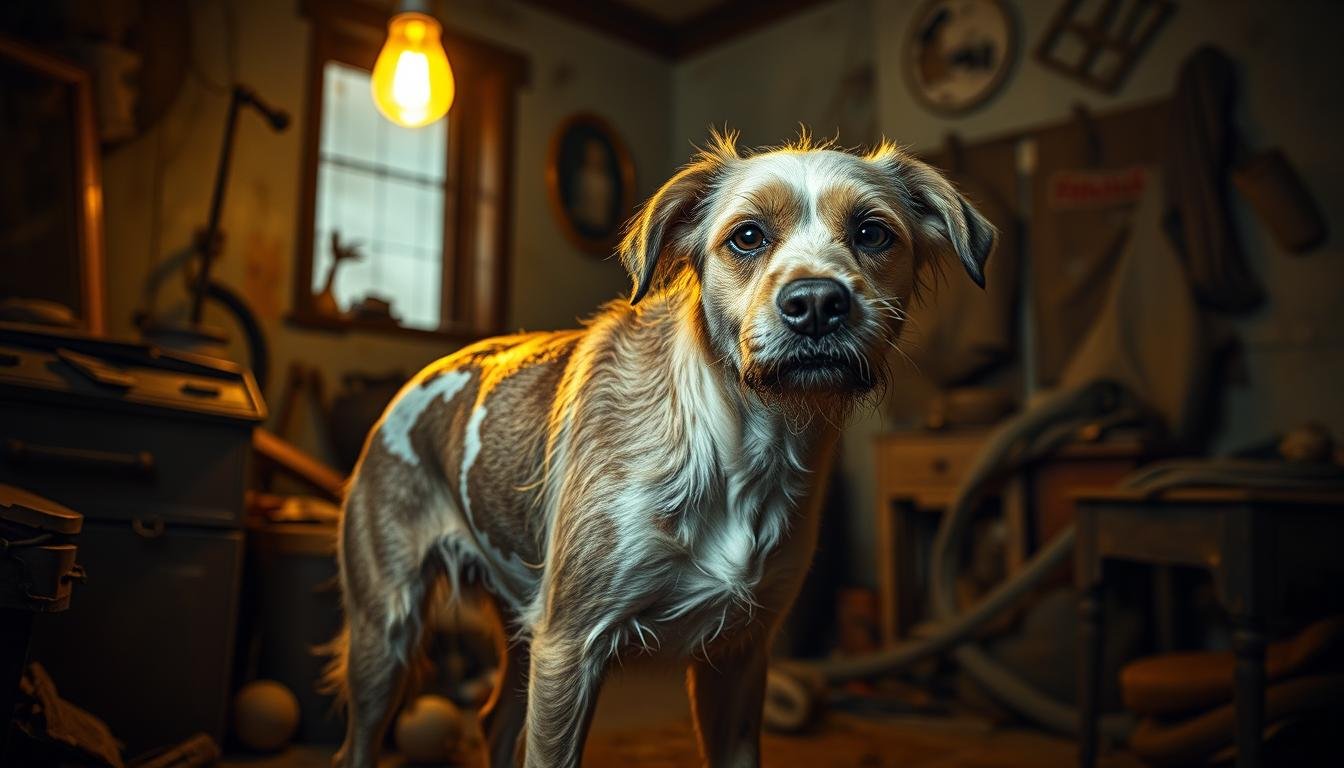Is your dog experiencing relentless itching and hair loss? Mange, a common skin condition caused by mites, could be the culprit. Understanding the type of mange your dog has is crucial for effective treatment. While some cases can be managed at home, others may require veterinary care to prevent complications like secondary infections.
Sarcoptic mange and demodectic mange are the two main types, each requiring a different approach. Sarcoptic mange is highly contagious and can even spread to humans, making prompt treatment essential. Demodectic mange, while less contagious, often signals an underlying issue with your dog’s immune system.
A proper diagnosis is the first step in any treatment plan. According to PetMD, misdiagnosing mange for skin allergies can lead to prolonged suffering for your pet. Early detection can prevent severe symptoms like hair loss and skin irritation.
Key Takeaways
- Mange is a parasitic skin disease causing itching and hair loss in dogs.
- Sarcoptic mange is contagious to humans and other animals, while demodectic mange is not.
- Early diagnosis is critical to avoid complications like secondary infections.
- Home remedies can help manage symptoms but may not eliminate the condition.
- Consulting a veterinarian is essential for severe cases or uncertain diagnoses.
Understanding Mange in Dogs
Is your dog suffering from relentless itching and hair loss? Mange, a skin condition caused by microscopic mites, could be the cause. Understanding the type of mange your dog has is crucial for effective treatment. While some cases can be managed at home, others may require veterinary care to prevent complications like secondary infections.
Sarcoptic mange and demodectic mange are the two main types, each requiring a different approach. Sarcoptic mange is highly contagious and can even spread to humans, making prompt treatment essential. Demodectic mange, while less contagious, often signals an underlying issue with your dog’s immune system.
A proper diagnosis is the first step in any treatment plan. According to PetMD, misdiagnosing mange for skin allergies can lead to prolonged suffering for your pet. Early detection can prevent severe symptoms like hair loss and skin irritation.
Key Takeaways
- Mange is a parasitic skin disease causing itching and hair loss in dogs.
- Sarcoptic mange is contagious to humans and other animals, while demodectic mange is not.
- Early diagnosis is critical to avoid complications like secondary infections.
- Home remedies can help manage symptoms but may not eliminate the condition.
- Consulting a veterinarian is essential for severe cases or uncertain diagnoses.
| Type of Mange | Characteristics | Symptoms | Risk Factors |
|---|---|---|---|
| Sarcoptic Mange | Highly contagious, caused by Sarcoptes mites | Severe itching, hair loss, skin infections | Exposure to infected animals |
| Demodectic Mange | Linked to immune system issues | Hair loss, skin thickening, infections | Poor immunity, underlying health conditions |
Recognizing Signs and Symptoms
Identifying the signs of mange early can significantly improve your dog’s recovery process. This skin condition often manifests through visible changes in your dog’s coat and behavior.
Common Skin Reactions and Hair Loss
Dogs with mange may exhibit patchy hair loss, especially around the face, legs, and ears. The skin in these areas can become red and inflamed, with crusty lesions forming over time. In severe cases, this can lead to secondary infections, which require immediate veterinary attention.
Intense itching is another hallmark of sarcoptic mange. Dogs may constantly scratch or chew at affected areas, causing further skin irritation. This relentless itching can disrupt your dog’s daily activities and overall well-being.
When to Isolate Your Dog
Sarcoptic mange is highly contagious, not only to other dogs but also to humans. If your dog shows signs of this condition, it’s crucial to isolate them to prevent the spread of the mites. This is especially important in multi-pet households or areas with frequent animal interaction.
Demodectic mange, while less contagious, still requires careful monitoring. It often appears in dogs with weakened immune systems, such as puppies or older dogs with underlying health issues. Early detection and treatment can prevent the condition from worsening and reduce the risk of secondary infections.
Regular grooming and skin checks are essential for catching mange early. If you notice any unusual skin changes or excessive itching, consult a veterinarian promptly to ensure the best outcome for your pet.
Diagnosing Mange: When to Seek Veterinary Help
Accurate diagnosis is the first step in effectively addressing mange in dogs. Without a proper diagnosis, treatment may be ineffective or even worsen your pet’s condition.
Diagnostic Methods and Skin Scrapings
Veterinarians use several methods to diagnose mange. Skin scrapings are the most common, but they can be inconclusive for sarcoptic mange due to the mites’ deep burrowing. In such cases, biopsies or other tests may be necessary.
- Diagnosis is crucial before starting any treatment to avoid ineffective remedies.
- Skin scrapings and microscopic exams are common diagnostic tools.
- Sarcoptic mange often results in false negatives, requiring a vet’s assessment.
- Vets distinguish mange from conditions like allergies, ensuring proper treatment.
- Seek immediate veterinary help if symptoms persist or worsen.
| Diagnostic Method | Description | Purpose |
|---|---|---|
| Skin Scrapings | Collecting skin cells for microscopic examination | Identify mites and assess skin condition |
| Microscopic Exams | Lab analysis of skin samples | Detect mites and rule out other conditions |
| Biopsies | Tissue sampling for detailed analysis | Confirm diagnosis when other tests are inconclusive |
A veterinarian’s expertise is vital for an accurate diagnosis and effective treatment plan. Early professional intervention can prevent complications and improve your dog’s recovery prospects.
Home Remedies for Mange Care

Natural ingredients can provide relief for dogs with mange. These remedies offer a gentle way to soothe skin and reduce mite infestations.
Natural Ingredients and Their Benefits
Honey is known for its antibacterial and anti-inflammatory properties. It can be applied directly to affected areas to soothe irritated skin and promote healing.
Apple cider vinegar, when diluted with water, helps balance your dog’s skin pH, creating an environment less favorable for mites.
Application Techniques and Safety Tips
Olive oil and lemon can be mixed to reduce mite populations while moisturizing your dog’s coat. Apply this mixture gently, ensuring it doesn’t get into sensitive areas.
Aloe vera is another effective remedy. Apply it a few times a week to soothe skin irritation and promote healing.
| Remedy | Benefits | Application Method |
|---|---|---|
| Honey | Soothes skin, reduces inflammation | Apply directly to affected areas |
| Apple Cider Vinegar | Balances skin pH | Dilute with water and use as a rinse |
| Olive Oil and Lemon | Reduces mites, moisturizes coat | Mix and apply gently |
| Aloe Vera | Soothes irritation, promotes healing | Apply a few times a week |
Always test a small area first to check for any adverse reactions. If symptoms persist, consult a veterinarian for further guidance.
how to treat mange in dogs at home: Effective Strategies
Treating mange in dogs requires a combination of proper care and attention to detail. While home remedies can help manage symptoms, it’s essential to follow a structured approach for effective results.
Step-by-Step Home Treatment Process
Begin with a medicated shampoo, gently massaging it into your dog’s coat. Let it sit for 5-10 minutes before rinsing thoroughly. This helps remove mites and soothe the skin.
Next, apply a topical treatment like olive oil or aloe vera. These natural remedies can suffocate mites and reduce irritation. For severe cases, a diluted hydrogen peroxide solution can be used, but always consult a vet first.
Monitoring Progress and Adjusting Remedies
Keep track of your dog’s condition, noting improvements in skin health and reduced itching. If symptoms persist or worsen, it’s time to adjust your treatment plan or seek professional help.
| Treatment Type | Instructions | Frequency |
|---|---|---|
| Medicated Shampoo | Apply, let sit, rinse thoroughly | 2-3 times a week |
| Topical Applications | Apply oil or aloe vera directly | Daily or as needed |
| Hydrogen Peroxide Solution | Dilute and apply gently | Every 3-4 days |
Consistency is key. Regular grooming and maintaining a clean environment will support your dog’s recovery and prevent re-infestation.
Supporting Your Dog’s Immune System

Nurturing your dog’s immune system is vital for their recovery from mange and overall health. A robust immune system not only helps your pet combat mites but also prevents future infestations.
Nutrition, Supplements, and Multivitamins
A well-balanced diet is the cornerstone of immune support. Feeding your dog high-quality food rich in essential nutrients can strengthen their system. Additionally, supplements like Omega-3 fatty acids and multivitamins promote skin health and resilience against mange.
| Supplement | Benefits | Application |
|---|---|---|
| Omega-3 Fatty Acids | Reduces skin inflammation | Oral administration |
| Multivitamins | Boosts overall health | Daily with meals |
| CBD Oil | Soothes skin and reduces itching | As directed by vet |
Combining a balanced diet with proper treatment can lead to faster recovery and long-term skin health for your pet.
Creating a Safe Environment for Recovery
Ensuring your dog’s living space is clean and free from mites is essential for their recovery. While demodectic mites rarely survive away from their host, sarcoptic mites can linger in the environment, posing a re-infestation risk. This makes thorough house cleaning and proper bedding care crucial steps in your pet’s treatment plan.
House Fumigation and Bedding Care
Thoroughly fumigate your home to eliminate any remaining mites. Use a steam cleaner on carpets and upholstered furniture, as heat is an effective way to kill mites. For hard surfaces, use a chemical spray specifically designed to target parasites. Always follow the product instructions to ensure safety for both your pet and family members.
Replace any bedding or soft furnishings that your dog has come into contact with. If replacement isn’t possible, wash items in hot water (at least 120°F) and dry them on a high heat setting to kill mites. Consider using a dryer for items that can’t be washed, as the heat will help eliminate any remaining parasites.
Protective Measures and Routine Cleaning
During the cleaning process, keep your dog isolated to prevent re-exposure. Wear protective gloves and a mask to avoid any potential transfer of mites to yourself. After cleaning, allow the area to air out before letting your dog return.
Establish a routine cleaning schedule to maintain a mite-free environment. Regularly vacuum carpets, especially in areas where your dog frequents, and dispose of the vacuum bag or empty the canister immediately to prevent mites from escaping. Mop hard floors with a mild detergent to keep them clean and reduce the risk of re-infestation.
For an extra layer of protection, consider using diatomaceous earth—a natural, non-toxic substance that can be sprinkled on carpets and pet areas before vacuuming. This powder dehydrates mites, making it an effective and safe alternative to chemical treatments.
By taking these steps, you can create a safe and comfortable recovery environment for your dog, reducing the risk of re-infestation and supporting their overall well-being.
Conclusion
Effectively managing mange requires a combination of proper diagnosis, timely treatment, and consistent care. Understanding the differences between sarcoptic and demodectic mange is key to addressing your dog’s specific needs. Sarcoptic mange, being highly contagious, demands immediate attention to prevent spreading to other pets and humans. Demodectic mange, while less contagious, often indicates underlying immune system issues that need addressing.
Early diagnosis and intervention are critical. A veterinarian’s expertise ensures accurate identification of the condition, preventing misdiagnosis and ineffective treatments. Home remedies like olive oil and aloe vera can provide relief, but severe cases may require professional veterinary care to avoid complications.
Maintaining a clean environment and boosting your dog’s immune system through proper nutrition are vital for recovery. Regular grooming and a balanced diet can prevent re-infestation and support skin health. If symptoms persist, consult your veterinarian promptly to ensure the best outcome for your pet.





Interesting read, but wouldnt it be safer to consult a vet first before trying home remedies for such a serious condition?
Does anyone else question the effectiveness of treating mange at home? Isnt vet supervision crucial for serious conditions like these?